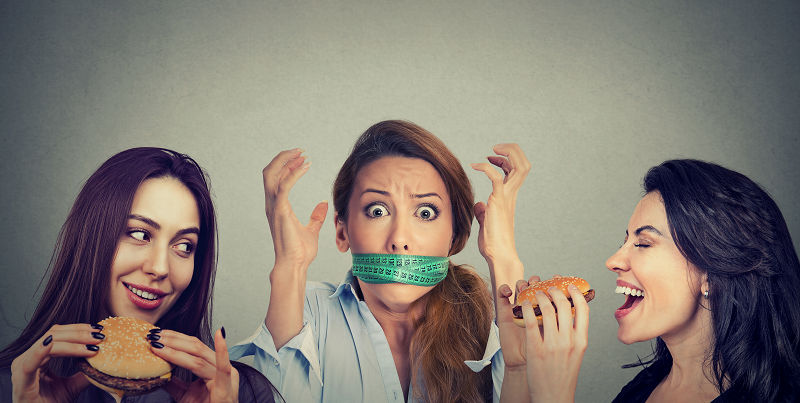
5 Ways to Beat Food Cravings Naturally
You know those nagging ‘hunger’ pangs – the ones that seem to so easily derail your weight loss efforts? The only problem is…you know it can’t be actual hunger because you ate something substantial just an hour ago. So, they are not hunger pangs, they are really food cravings. These urges to eat can be caused by a combination of both physiological factors (such as low blood sugar and/or hormones) and situational factors (such as the fact that you always tend to have a Danish with that coffee). The real problem is not the fact that we face cravings; it’s that we give into them too often.
Food cravings are incredibly powerful. They are fuelled by brain chemicals such as dopamine, released in response to high fat or high sugar foods that create that ‘rush’ of euphoria that our brain seeks over and over again (pure pleasure!). Despite this, we know they don’t tend to serve us well. Because giving into these cravings sets us up for failure, and leaves us feeling sick, bloated and downright fed up. So try these simple tips to put the brakes on cravings when they hit – like anything, the more we practise, the easier it gets.
1 Distract
We may not be able to avoid the food completely (such as that chocolate biscuit that your colleague or friend is offering you), but we can create a diversion so we don’t notice as much. Automatically say ‘no’ and then the key is to do something different in order to break the pattern. Ideally, choose something pleasurable. If we’re at home, going upstairs and lying down on a bed to read a book or listen to music (or try meditation – read about the benefits here) can work incredibly well at derailing cravings. Using water can also be a fantastic distraction – drinking it, splashing it on our faces or showering or bathing in it are all brilliant ways to ‘reboot’ the brain into a new pattern. Other pleasurable distractions include a nice cup of herbal tea, a massage, a facial or a new magazine. A hug from a partner, child or friend will do too!
2 Move Location
Avoid the boardroom for lunch if the only thing on offer is sandwiches, scones and pastries. Have a healthy snack before you go into your meeting – such as Greek yoghurt with blueberries or hummus with carrot sticks – and then ensure that you have a healthy, filling salad planned for just afterwards. The key is to break the automatic response to dive into food that you know will be high sugar or packed full of processed, white carbs. Some cravings are triggered by memory and geography – so if you pass a take-away restaurant that you used to frequent a lot, now it’s time to divert your route to another one. If you tend to reach for a scone each time you have a coffee with that friend, invest in your own coffee machine and invite him or her over. If you have cake every time relatives invite you over, bring your own healthier dessert option (such as our sugar-free lemon cake).
3 Surf the Urge
Sometimes distraction or taking ourselves away just don’t work. Some experts believe that suppressing urges (like emotions) can actually make them stronger. But people don’t realise that they can take control of their urges with some simple techniques. Food cravings behave like waves; they build, crest and then disappear. Often people mistakenly believe that they will build in intensity until they become overwhelming. In other words, people give in too early. Experts recommend ‘urge surfing’ to beat cravings. This technique was originally designed for smoking cessation and has proved very successful. Here is a description of how it works and here is a YouTube video that talks you through it.
4 Eat Something – the Right Thing
Sometimes it’s appropriate to eat something when we are hit with a strong craving. Try substituting fruit for refined sugar when you crave something sweet (but also have some protein with it, such as Greek yoghurt). If you crave chocolate, having an extra protein bar might be the right decision that day. Similarly, a spoonful of almond or peanut butter can have a similar effect (the healthy fats in the nut butter seem to hit the right parts of the brain and palate to trigger satiation). For me, a handful of olives or almonds work well, as does replacing white carbs with wholegrains such as oats, quinoa and brown rice or barley, whilst also making sure to include lots of pulses such as lentils and chickpeas (these contain fibre that fill you up and do not cause the dramatic spike in insulin that refined carbs do).
5 Identify Difficult Emotions
Although food cravings aren’t always the result of emotions, there’s no denying the connection that often exists. Sometimes we spend a lot of time running away from our real thoughts or emotions – because they’re uncomfortable of course. But we would benefit so much from being more honest with ourselves, instead of ‘eating our emotions’. Relaxation and meditation are great ways to tap into these true feelings. If we eat in response to difficult emotions, then it makes sense that these feelings need to be managed first. A useful technique is to use the ‘name and tame’ technique – which is about putting a name to the emotion (eg. ‘I’m angry’) and taming it (‘what can I do now to manage this emotion better’? What are my choices?). Incredibly, just naming our emotions can actually help us calm them – watch this video.



